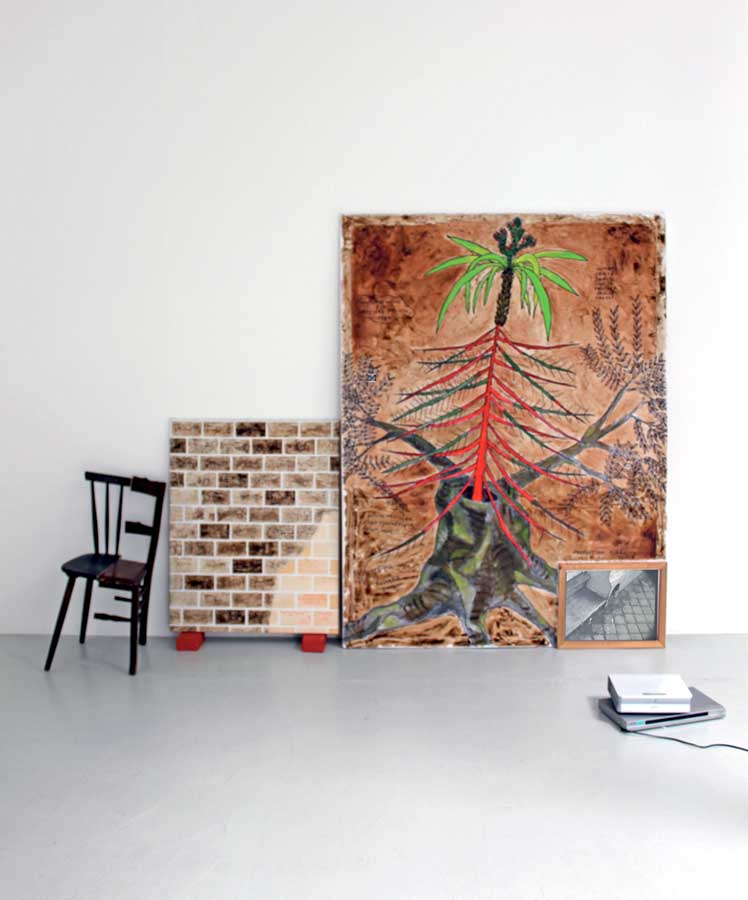Jacques Lizène participe à un vaste programme international qui regroupe quatre institutions européennes : le Van Abbe Museum d’Eindhoven, le MACBA de Barcelone, le Muhka d’Anvers et la Moderna Galerija de Ljubiana en Slovénie. Cette Internationale souhaite, en sa qualité de cadre coopératif alternatif, parvenir à se profiler à travers des projets transnationaux et plurivoques et donner de la visibilité aux concordances qui caractérisent les collections respectives des musées participants. Ce premier projet est une approche innovante des avant-gardes des années 1956-1986, au travers d’expositions, de colloques et séminaires.
Museum of Affects réunit des œuvres d’art réalisées dans des conditions très différentes : sous des régimes totalitaires dans l’ancien bloc de l’Est et en Yougoslavie, sous la dictature de Franco en Espagne, sous la junte militaire argentine qui assassinait « l’ennemi public » ou la junte brésilienne qui l’exilait… Mais aussi des œuvres réalisées aux États-Unis qui dominaient le monde de l’art à cette époque, ou en Europe occidentale, qui considéraient les États-Unis comme son grand frère et son exemple. Néanmoins, on retrouve – à partir de cette diversité – des valeurs communes dans ces œuvres. Non pas les caractéristiques formelles, mais une notion d’intensité, et celle-ci fait office de fil conducteur : quel était l’enjeu de l’artiste quand il/elle a créé son œuvre ? Qu’est-ce qui comptait pour lui/elle à ce moment-là et quel résultat espérait-il/elle ?

Chaise découpée, Art Syncrétique 1964, en remake. 2008. 83 x 40 x 35 cm. 12. Etre son propre tube de couleur, 1977. Peinture à la maière fécale. Peinture analitique (sans y). Remake 1995. Technique mixte sur toile. 100 x 80 cm 13. Peinture à la matière fécale, 1977. Dessin médiocre d’art syncrétique, 1964. Olivier croisé sapin croisé palmier croisé cactus. Remake 2010 et projection vidéo. Technique mixte sur toile, 200 x 150 cm (collection Muhka)
Le communiqué du musée de Ljubjana
26 November 2011 – 29 January 2012
Museum of Contemporary Art Metelkova
Ljubljana, Slovenia
Opening of the exhibition, Saturday, 26 November, 8 p.m.
Curated by: Bart de Baere, Bartomeu Marí with Bojana Piškur, Leen De Backer, Teresa Grandas
The Museum of Affects exhibition brings together four important European museums: Moderna galerija, Ljubljana, the Museu d’Art Contemporani de Barcelona (MACBA), Barcelona; the Van Abbemuseum, Eindhoven; and the Museum van Hedendaagse Kunst, Antwerpen (M HKA). The institutions have joined forces to challenge the present canons of art history and replace them with transnational, pluralistic cultural narratives and approaches.
How to go about this? How to address similarities and differences in a new way? The Museum of Affects exhibition is one possible approach. It brings together works that emerged out of various events between 1957 and 1986. The circumstances under which these works were produced range from the totalitarian regimes in the former Eastern Bloc and Yugoslavia to the cultural oppression under Franco’s regime in Spain and the specific situation in the Lowlands. In addition, pop art, minimalist, and conceptualist works from the then hegemonic North American art system are included in the show.
The main focus of the exhibition is not the formal and cultural positioning of these works, neither is it a comparative analysis between them, but rather the notion of affects, the power of affecting and being affected. We define this power as a resonance with artworks, where artworks become events made of intensities, which leave certain traces in space and time and, above all, on or within our bodies and minds.
Affects involve both feeling and cognition; a sensory experience and an intellectual activity. What is more, affects are also a change, a politics, a rupture, an unknown power. Affects cannot be instrumentalized because they cannot be read or represented. On the other hand, affects can be controversial, especially when linked to certain ideologies and/or totalitarianisms.
What then are the intensities that inform a work? What is the potentiality of an artwork? How do we think of art as event? And how do we work out the antagonisms between affects, representation and the art system in the exhibition itself?
Questions such as these force us to think beyond the defined methodologies of academic art history and its formal analyses, which might incite a different kind of approach towards the exhibited works; or more precisely, the idea of the exhibition is not so much about interpreting the works of art as it is about the specific affective experiences that these works trigger.
For this reason the following groupings were applied: the desire for actual social change through the critique of the system and the media; the desire for symbolic social change and the creation of alternative systems; understanding the world by making invisible structures or energies visible; using the world as material for ironic critique; the desire to articulate the world as semantics and immediacy; and articulating the self in the world as experience.
Participating artists:
Francesc Abad, Marina Abramović, Vito Acconci, Eugenia Balcells, John Baldessari, Dimitrije Bašičević Mangelos, K.P. Brehmer, Stanley Brouwn, James Lee Byars, René Daniels, Paul De Vree, Luc Deleu, Daniel Dewaele, Lili Dujourie, Miklos Erdely, Öyvind Fahlström, Esther Ferrer, Robert Filliou, Dan Flavin, Ferran Garcia Sevilla, Jef Geys, Tomislav Gotovac, Eulalia Grau, Ion Grigorescu, Grupo de Artistas de Vanguardia, Grup de Treball, Tibor Hajas, Richard Hamilton, Nigel Henderson, René Heyvaert, Hamlet Hovsepian, Sanja Iveković, On Kawara, Julije Knifer, Jiři Kovanda, Vladimir Kuprijanov, Jacques Lizene, Ivica Matić, Danny Matthys, Guy Mees, Miralda, Jan Mlčoch, Andrej Monastirsky, Muntadas, Bruce Nauman, Video-Nou / Servei de Vídeo Comunitari, the OHO group (Milenko Matanović, Marko Pogačnik), Panamarenko, Carlos Pazos, Josep Ponsatí, Manolo Quejido, Joan Rabascall, Gerhard Richter, Martha Rosler, Benet Rossell, Ed Ruscha, Mladen Stilinović, Ilija Šoškić, Petr Štembera, Toon Tersas, Anne-Mie Van Kerckhoven, Josip Vaništa, Andy Warhol, Lawrence Weiner